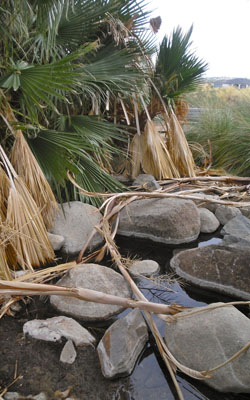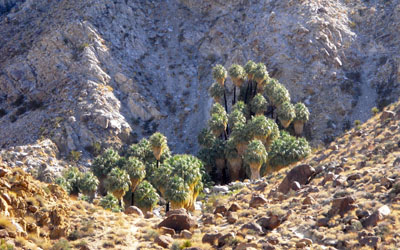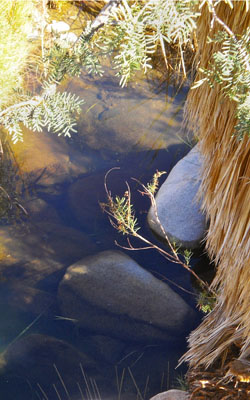
Palm oases add color to park’s desert
TWENTYNINE PALMS, Calif. — Known for dry hot weather and a barren sand and rock terrain, the last thing people think of when referring to a desert is lush greenery and supple water.
However, the fan palm oases of Joshua Tree National Park defy this description.
Of less than 200 palm oases in all of North America, this national park is home to five. Thriving off of the warm climate and groundwater availability, fan palms thrive in certain elevations throughout the 1,235 square miles of protected parkland in Southern California.
The fan palm oases located in Joshua Tree provide color and life to the otherwise desolate land in the Mojave and Colorado deserts. Some of the oases are tucked in the crevices of rocky mountains, while others are just a short walk from the visitor center.
 |
The small amount of water in the Oasis of Mara at Joshua Tree Nationall Park is surrounded by debris and fallen palm branches. When Native Americans inhabited this area, they would use prescribed burning to clean out dead branches, however, Joshua Tree National Park does not use this method due to fire regulations (Photos by Kelsey Pinault). |
Aside from being a breath-taking sight and natural wonder, these isolated areas are beneficial to wildlife and people in the areas. When Native Americans inhabited the land of Joshua Tree, they used these oases as a source of water, shelter, food and shade from the hot desert sun. The natural desert springs are also key in the survival of animals in the desert.
“People visiting the park often report seeing animals such as bighorn sheep in these areas because it is one of the few sources of water,” said Joe Zarki, chief of Interpretation at Joshua Tree National Park.
Other animals such as quail, coyotes and kangaroo rats can be seen in these areas as well.
One of the easiest oases to access, the Oasis of Mara, is located right outside the Twentynine Palms park entrance. The city was named by gold miners who settled in the area in the late 19th century after the vast amount of palms located in this oasis. Although many of these palms are still standing today, the town was built around this site and has caused some damage to the area.
“We have to pump some water into the area every once in a while to keep the trees healthy, so it’s a little less natural than some of our other oases,” said Zarki.
 |
After about one mile of hiking, the bright greens of Fortynine Palms Oasis is visible in the distance. |
Another oasis in the park, Fortynine Palms, is known as one of the most beautiful sights to see in Joshua Tree. After a mile and a half long path that twists up and down hills, views of rock formations and cactuses turn to a vivid cluster of towering fan palms. Seeing the leafy greens and colorful flower plants at a distance almost seems like a mirage, however the palm trees are a staple in the desert, nesting a bank of fresh spring water.
“It’s amazing to go from all this dryness to see lush moist areas. Just imagining when Native Americans would finally make it to this point and have that feeling of finding water and relief from the heat makes it really interesting,” said Caroline Sims, who visited the park from Chicago.
Some of the most popular oases located in the Cottonwood Spring area of the park were closed to the public due to a flash flood in 2011. Fortunately, none of the fan palm oases were harmed, as floods can sometimes be detrimental to such areas. When unexpected events occur such as the floods, the damaged areas of the park are closed and scheduled to reopen when the area is at a healthy state again.
“The flood was beneficial because it cleaned out all of the debris, so now you can see right into the oasis,” said Pam Tripp, an interpretive ranger who has worked at Joshua Tree National Park for more than five years.
Many people visit the oases, finding the hikes appealing, and are amazed by what they see. Working on desert restorations in other regions, visitor Miranda Kersten didn’t expect her visit to Joshua Tree to be out of the ordinary.
“Even after working in other deserts, I didn’t realize like this could exist here,” said Kersten.
Even locals appreciate the beauty the fan palm oases bring to this southeastern part of California. Donnette Swain, a principal at a local Twentynine Palms school, hikes the Fortynine Palms Trail as a form of exercise when she finds the time.
“It’s a perfect loop to hike, and the view of the oasis in the middle never gets old. It’s my favorite trail,” said Swain.
Joshua Tree National Park is a place of many wonders, attracting visitors from all over the world. The fan palm oases spread throughout the park offer this desert something unique from any other, as they are truly a natural wonder.
| Unusual in dry and hot desert climates, Fortynine Palms Oasis, as well as the other oases in Joshua Tree National Park, provides a source of natural spring water benefiting all of the wildlife in the area. |  |
If You Go
Joshua Tree National Park has three main entrances:
- West entrance: five miles south of the junction of State Highway 62 and Park Boulevard at Joshua Tree Village.
- North entrance: in Twentynine Palms, three miles south of the junction of State Highway 62 and Utah Trail.
- South entrance: at Cottonwood Spring, can be accessed from the east or west via Interstate 10.
Hours of operation: Joshua Tree National Park is accessible at all hours, but some trails are closed at night.
Facilities: Restrooms are located before most trails. Gift shops and visitors centers are located at the park entrances.
Fees: Seven-day vehicle pass: $15; seven-day single entry pass: $5; annual pass (entry for signee and guests): $30.
Fan palm oases sites:
- Oasis of Mara: short walk from the Oasis Visitor Center in Twentynine Palms, California: From State Highway 62, head South of Utah Trail to access the Oasis Visitor Center parking lot.
- Fortynine Palms Trail: three mile round trip located off Park Boulevard on Canyon Road: From State Highway 62, head South of Canyon Road to access the Fourtynine Palms parking lot.
- Other oases including Lost Palms Oasis and Cottonwood Springs Oasis: trails are accessible from the Cottonwood Springs park entrance, which lies 25 miles east of Indio, can be approached from the east or west, also via Interstate 10.
For more information: Visit: http://www.nps.gov/jotr or call: 760-367-6392.

Comments are Closed